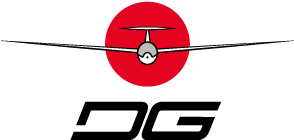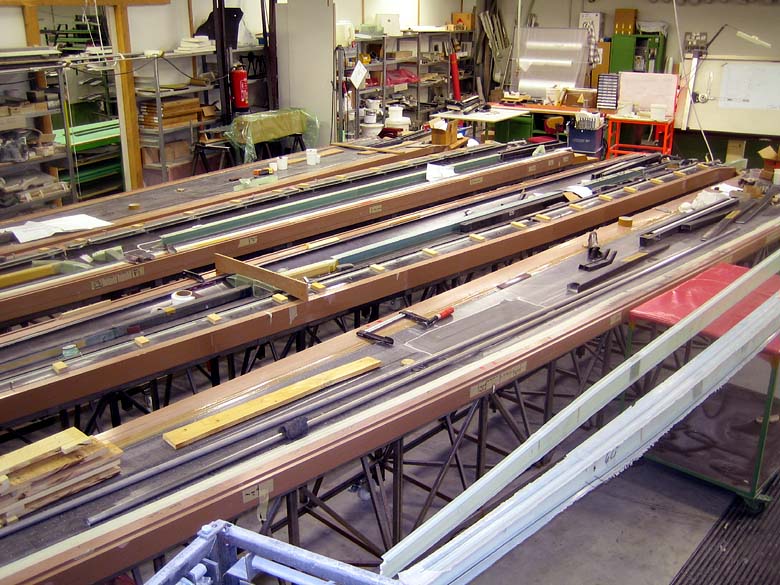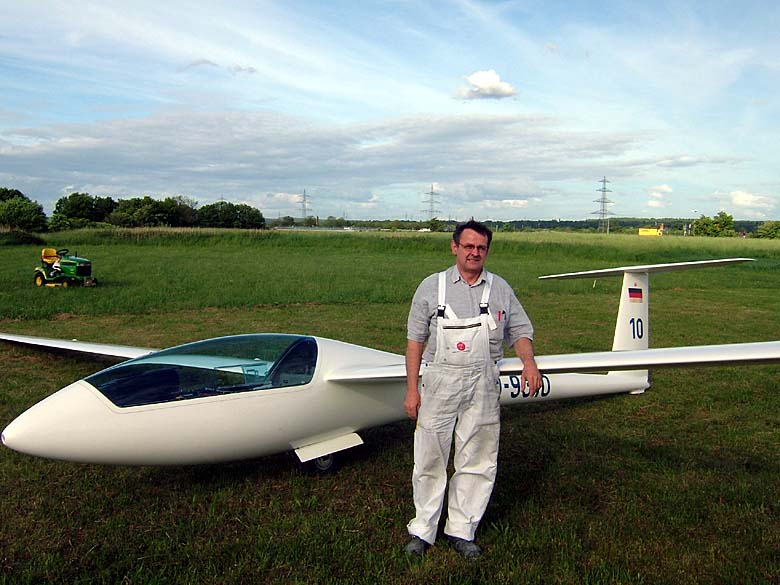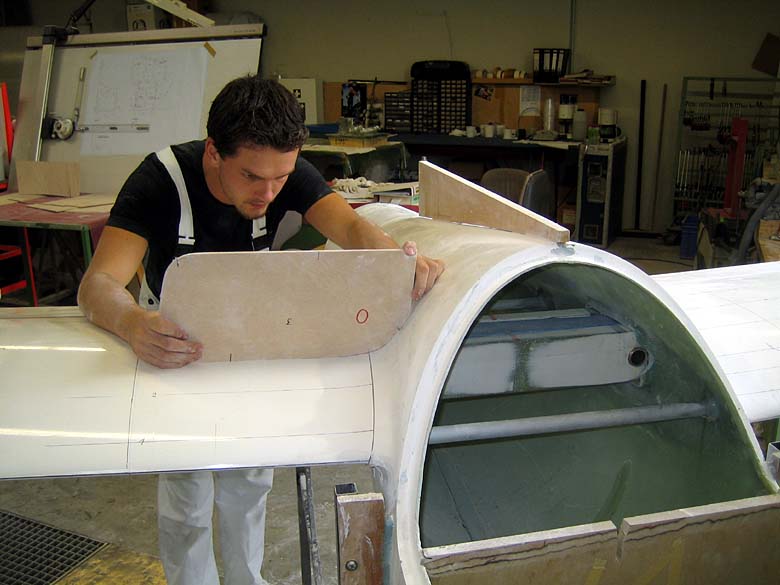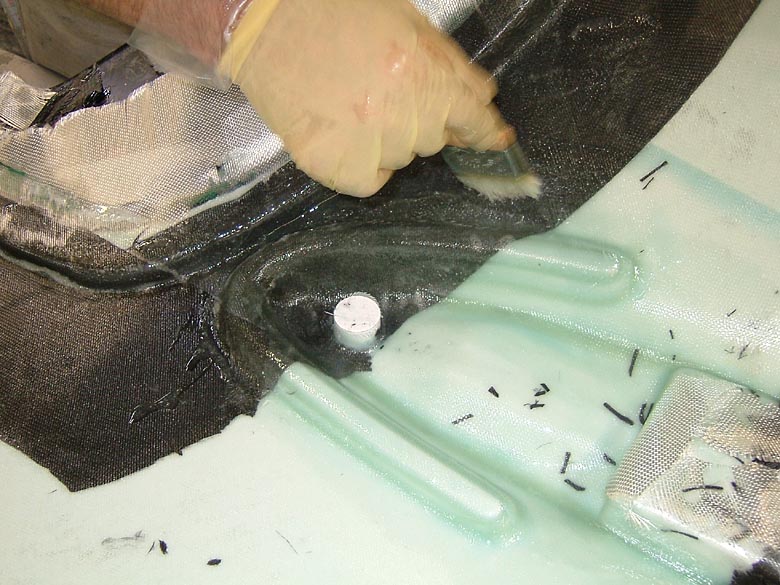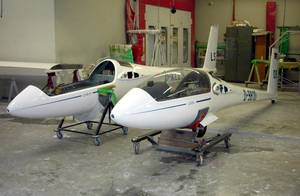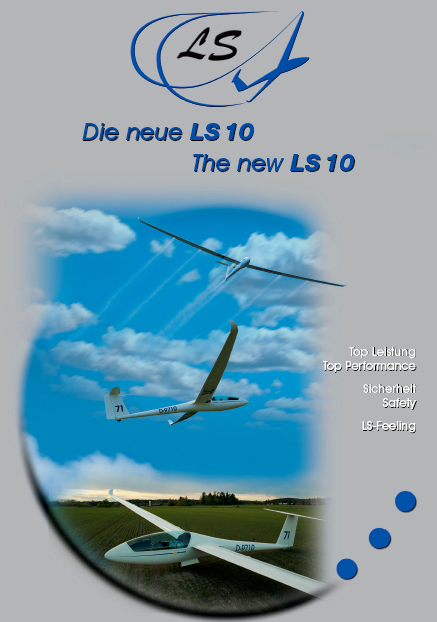
identify strengths and weaknesses alike. This input was gathered and compared with our customer feedback.
The resulting insights were used to define the requirements for the new LS10 – “Made by DG”. One key principle
was not to “DG-ize” the LS10 but rather maintain the typical LS characteristics.
The LS 10 will differ in the following areas from the existing model:
-
All LS10 gliders will be engine-ready. That is to say, to simplify production all LS10 gliders will have the engine box built into the fuselage. All LS10 ordered in the glider-only version will offer the option of retrofitting a sustainer engine later. This should be a clear plus in maintaining/enhancing the resale value of LS10’s.
-
The typical LS toe brake actuation will be replaced by a drum break actuated by the dive brake lever (in its fully deployed position). The “Haenle” guides for the ailerons remain.
-
There are no changes to the LS-type elevator assembly, but the outer wing panels trade-in the old threaded bolt for a spring loaded locking pin for easier assembly.
-
The skids on the wingtips remain (no wheels) as there will be no self-launching version.
-
As for the partitioning of the wings into two panels each, lengthy debates ensued. The result? All versions of the LS10 will feature 4 wing panels, i.e. each wing will be partitioned into two panels for all versions and configurations of the LS10. This design ensures easier assembly and allows for the use of a shorter trailer. As for the location of the paring between inner and outer panels, the further out toward the wing tip the designer places the divide, the easier the assembly and the cheaper and lighter the required connection for the wing spar. In the limit of parting at y=7.25m however, the resulting wing tips of 0.25m for the 15m wing plan form lead to suboptimal performance characteristics. If the divide is moved too far toward the wing root, the outer panels become so heavy that they cannot be handled by one person. In addition, this also raises the total weight of the wing substantially, which in turn leads to a more expensive overall wing design. The best compromise is for the parting to be at y=7m. This results in 2m outer panels for the 18m version, a size that can still be handled effectively by one person. Combing the resulting 0.5m wingtips for the 15m version with “high” winglets leads to an aerodynamically optimal plan form for this version as well.
-
The 18m wing plan form will feature the well-known LS curved winglets.
-
All LS10 gliders will be designed to accommodate a bug wiper system. Integrating this option into the design of the LS10 allows for the installation of a lower drag bug wiper system.
Meanwhile the second LS10 is under construction at our facility in Bruchsal.
This particular LS10 will still be manufactured according to the original Rolladen-Schleicher design. Here you can see, how we measure and design at the same time!
– friedel weber –
Translation: Kai Talarek
Maiden Flight of the LS10 – No. 2
Just in time for the world championships in Sweden, the LS10 with production number 2 took off for her maiden flight. She flew just great and will be picked up for training flights in only a matter of days.
On this picture Helge Kennel is representing the whole team in front of the aircraft. In the last couple of days, he has spent more time on this plane than at home.
Management is very grateful to him especially and to the whole team as well!
This aircrafts construction was begun by Rolladen-Schneider and was suffering from delays due to the well-known legal problems.
Its design is still identical to the “original”, as is production no. 1. The design of number 3 is currently being completed. It will include a number of improvements and will serve as the basis for serial production.
The development goes on
The development of the LS10-s and the LS10-st to the production stage goes on with might and main in Bruchsal.
Especially, a new and improved wing-fuselage-transition was created in order to reduce the fuselage-close turbulences. The fit of the wings of the prototype were not made properly, hence we build a special mock-up made from wood.
For us it is truly not enough to rebuild the concept of Rolladen-Schneider, although it was well developed. Otherwise our co-manager Holger Back would not have won the German National Gliding Championship!
Our aim is to build and bring a plane to the market with the technical achievements of the year 2007!
Meanwhile, you can find a correct data sheet of the
LS10-s and the LS10-st here.
And finally the 3-angle-view of the LS10-s:
Well:
The development goes on and on the Aero 2007 we will present the first LS10 – original from DG Flugzeugbau!
And after this you can expect the 15m version of the LS10 too.
This is another wooden mock-up for precise measurements of the main spar and its connection
– quite a lot of work until it flies…..
And here you can see the bug wiper garages at the first new designed LS10 fuselage
IDAFLIEG- Gauging
In 2002, the IDAFLIEG conducted some gaugings during their summer-meeting to analyze the influence of detached bug wipers on lift/drag ratio of a glider.
The results are not fully discussed so far , and yet are not to be published . Anyhow, it is known that the drag of detached bug wipers – the ones that are not retracted into a garage is unexpectedly high, resulting in a measurably higher sink rate.
You will be able to find more details here as soon as any official figures will be published.
LS10 – Modifications for production
Since the success in different competitions it has become a little bit quiet around the LS10 project well so it would appear. However, the truth is different. In Bruchsal we are working in high gear on the preparations for serie production. Unknown by the general public, the biggest part of the flight tests was already finished during the last weeks. The test pilot was Micro Scholz – former chief designer of Rolladen-Schneider – and presently working as an engineer in the Steinbeis Transfer Centre in Stuttgart.On account of his several years’ activity in the LS company he is most qualified for this task. Up to now all tests in the project ran without problems or hitches.
In parallel with the flight tests – in particular if the weather did not allow flights at all our staff worked on detailed solutions and modifications. The extensive testing of the two prototypes during the last months indicated the existing improvement potential.
The new fairings at the lower part of the vertical fin are evident.
Nevertheless, the biggest changes took place in the cockpit. For the series e.g. the position of the rudder pedal cavity foot tub was changed. Now there will be room for big feet.
To further improve the view out of the cockpit the instrument panel could be further lowered – without loosing space for the instrumentation. This is an essential contribution for more safety.
For safety reasons we also install a Piggott-Hook – for an explanation please have a look at here.
The operating forces of the water ballast system were clearly reduced. We also optimised the shape of the opening levers. Generally the focus was on improvement and optimization of the flight controls. Looking at the flap lever the changes in flap setting works more precisely and pilot-friendly – the handle is coated with fine leather. The decompression lever for starting the engine was moved and now is very well accessible. The position of the trim knob was optimized ergonomically and functions much better. The rudder pedal handle now retracts in the seat pan after use in the LS10 a unique detail in comparison to the long and dangling bowden cable of other airplanes.
Overall, the cockpit gives a very professional and tidy impression. The new demand to demonstrate sportiness inside and outside is underlined by the high-quality interior upholstery and small details, as for example the arm support editions in leather on both sides of the seat shell. Feeling comfortable in all details is the purpose which takes into account the Human Factors and guarantees top performance by racing free of tiredness.
Likewise very tall pilots will fit in the LS10 too by using an optional separate headrest which can be installed instead of the back support. The change can be done in a minute.
12.11.07
Production is running
It took some time until four prototypes and all moulds and positioning tools were ready. But now the normal production of the LS10 is running.
Certification Process is ready!
At June 17th Wilhelm Dirks has presented the LS10 in Braunschweig to the “Luftfahrt-Bundesamt”.
The final certification was given to us Dec. 18th, 2009.
Now everything is ready.
The Flight Manual is available too.
